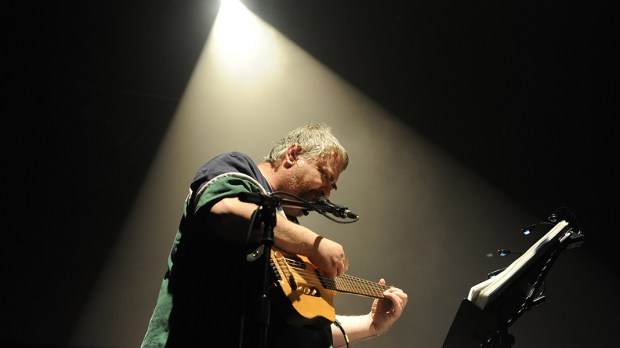Lenten Campaign 2025
This content is free of charge, as are all our articles.
Support us with a donation that is tax-deductible and enable us to continue to reach millions of readers.
A few months ago, I started singing Daniel Johnston’s
to my five-year-old daughter to help her drift off to sleep. It worked. One night, she surprised me by asking if she could sing along with me; unbeknownst to me, she had been silently memorizing the lyrics.After news of Daniel Johnston’s passing broke on September 11, I asked her if we could sing it again—this time for a friend named Daniel.
I first discovered Johnston in the mid-aughts while still in college. One of my brothers played me his song
—which has the classic chord organ, lo-fi sound of his early albums—describing him as an artist who had wrestled with insanity. I was intrigued. He pointed me to The Devil and Daniel Johnston, a 2005 documentary about his life—and I was hooked. To this day, his music has been a part of my life and my family’s life. In losing him, I really did feel like I had lost something of a friend.What was it about Daniel Johnston that captivated so many people, including Kurt Cobain (who famously wore a t-shirt with his cover art) and Simpsons creator Matt Groening? Simply put, he was the oddball’s oddball. Nobody made music or art quite like he did, because there was nobody quite like him.
Born the youngest of five children and raised in the Church of Christ family in West Virginia, Johnston was a thin, withdrawn kid with a love for comic books, good-vs-evil mythologies, and characters like Captain America, Casper, and King Kong. His passion for drawing and playing piano led him to the art program at Kent State, where a bad case of unrequited love—his muse famously married an undertaker—sparked an obsessive period of creativity in the 1980s. He moved in with family in Texas, scraping by with pizza deliveries and McDonald’s work; and he self-recorded raw, quirky, and brutally honest songs about love and pain, dreaming about being as big the Beatles.
But there are “tortured artists”—and then there are torturedartists. Johnston’s struggles with bipolar disorder manifested early, leading to a nervous breakdown during the recording of Hi, How Are You? in 1983. He made his way to Austin (the site of
) and began experimenting with drugs, precipitating a psychotic break; he was eventually hospitalized and diagnosed with schizophrenia. Stories of Johnston’s erratic behavior, many of which are documented in The Devil and Daniel Johnston, are abundant. To offer just one example, in 1988 his father was flying him home in a private plane, and Johnston—suddenly inspired by a Casper comic—pulled the key out of the ignition and threw it out of the window, forcing an emergency landing into the trees. Driving much of his behavior, though, were overwhelming perceptions of the demonic, later captured in haunting songs like and from the album 1990.But while much has been made about this dark side of Daniel Johnston’s life, it remained ingredient in a greater divine light, one that shone through his life in remarkable ways.
Daniel Johnston bore his broken heart, and mind, to a broken world; songs like
and powerfully articulated the loneliness and ennui experienced by so many today. Fulton Sheen once said that Jesus suffered the Agony in the Garden for the mentally ill—and that their lives reflect a continuation of that Agony. Johnston’s sufferings not only brought comfort to others in their suffering; they reflected the light of Christ, the suffering servant of God.They also resulted in some truly beautiful music. Johnston didn’t have a conventional singing voice—far from it—but the profound lyrics, gorgeous melodies, and perennial themes were there, and made you appreciate his high-pitched, off-key twang for its own strange loveliness. It’s no wonder so many artists—including
, , , , and others—have covered his work over the years, and why one song even recently found its way into .But behind the beauty and the suffering was his steadfast faith. The full nature of the relationship between his devout Christian upbringing, mental illness, and artistry is a mystery hidden in God. But the young Daniel Johnston clearly believed in the saving work of Christ—in an early song titled for example, he offers a profound little summary of creation, the fall, and the Paschal Mystery in a way that only he could—and he came to understand this faith as distinct from the mania that seized on it. “It was just a chemical imbalance in my brain,” he says about his struggles in a 2005 interview, adding that the getting the right medications “really helped a lot.” But he also continued to read the Bible, go to church, and believe in God—and the devil. Even at the height of his illness, a song like “True Love” seems to express not just the lament of a man who longed to be relieved of his own mind, but the hope of a Christian who longed to rest with his Lord.
Daniel Johnston was a man of sorrows, a creator of beauty, a keeper of faith—and while this light lives on in song, he will be greatly missed.
Eternal rest grant unto him, Oh Lord, and let perpetual light shine upon him.
You can donate to the “Hi, How Are You Project,” a mental health awareness nonprofit inspired by Daniel’s life and work, at HiHowAreYou.org.

